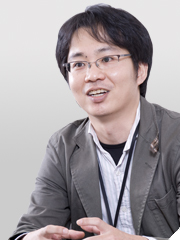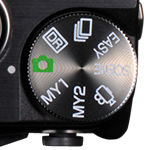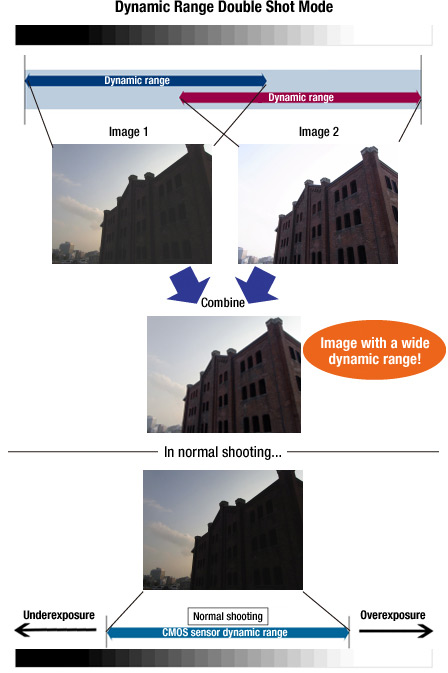Inside Story
To further expand "dynamic range"

"We added the dynamic range double
shot mode function, and we also
made it possible for the photographer
to quickly select it." (Makoto
Kanehiro)
"A special feature of the CX1 is that in addition to expanding the dynamic range in normal shooting, it also has 'dynamic range double shot mode' to give you an even more extreme dynamic range," said Makoto Kanehiro, who worked together with Yamada on the software development. A new "DR" setting has been added to the mode dial. Turning to DR puts you in "dynamic range double shot mode." So what kind of function is this?

"DR" (dynamic range double
shot mode) can be quickly
selected.
"For example, in scenes with a wide range of light and dark areas, such as those mixing shade and backlight, the bright areas can end up pure white or the dark areas pure black. However, quickly shooting two images with different exposures and then combining them enables the CX1 to produce images with a wide range of gradations all the way from the light areas to the dark ones," Kanehiro explained. Using this function results in a dynamic range of up to 12 EV, making it possible to create images giving a visual impression close to that of the human eye.

In dynamic range double shot mode, you can select four levels for the expansion effect: very weak, weak, medium, and strong. By selecting "+Normal shooting" on the shooting menu, you can also record a normal image. Since the introduction of the CX1, this new function has been very popular for "making photography more fun."
New possibilities realized through adoption of the CMOS image sensor (CMOS sensor), which features high-speed data transfer
"It is the adoption of a CMOS image sensor as the CX1's image sensor that enables it to take two shots with different exposures in quick succession," said Kanehiro. "Because of the high speed of its image data transfer, CMOS can shoot two images in almost the same instant." It was the quest for a wider dynamic range that led to the switch from CCD to CMOS for the CX1 image sensor. "This was the first time for Ricoh to use a CMOS image sensor, but we had already done a variety of technical development for mechanisms incorporating CMOS image sensor. To see the technology resulting from those efforts come to fruition in the 'CX1' and be displayed as a camera on store shelves is very exciting for me," he added.
- *CCD sensor and CMOS sensor are both image sensors that convert incoming light to electrical charges, but the signal read-write methods used differ, and each type of sensor has its own distinctive characteristics.


